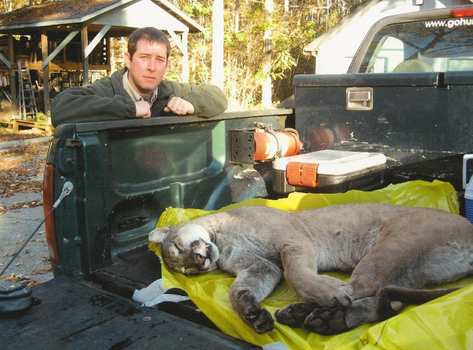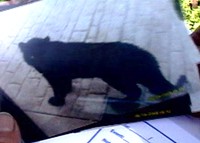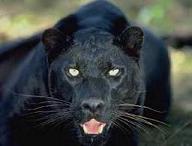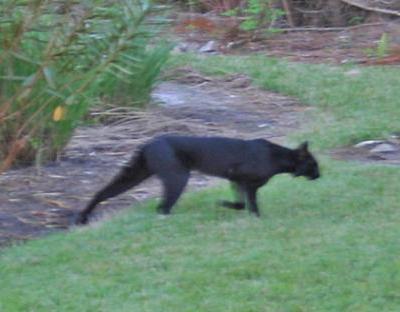
December 3, 2008

The Georgia Panther’s body is displayed above.
An Australian reader writes in, asking:
“Panther? I find the terminology all too confusing. Isn’t this cat [pictured above] killed a puma? Isn’t a panther always black, and either a jaguar or leopard?”
So, for this sincerely confused resident of Oz, what is the meaning of the term “panther” and what animals can be called a “panther”?
Well, technically, there are many meanings for “panther.” Using the source school children click to first, let’s see what Wikipedia says, as applied to the felids:
Large Cats
Panthera, the feline genus which contains lions, tigers, leopards and jaguars
Panther (in Africa and Asia), the leopard (Panthera pardus)
Panther (in North America), the cougar or mountain lion (Puma concolor)
Florida panther, a subspecies of cougar (Puma concolor coryi or Puma concolor couguar) found in southern Florida
Panther (in South and Central America), the jaguar (Panthera onca)
Black panther, a black variant of leopard, cougar or jaguar
White panther, a white or very pale variant of leopard, cougar or jaguar
Panther (legendary creature), a mythical creature resembling a large multicolored cat
Wikipedia didn’t seem to have a reference to “Phantom Panthers,” but if you’re reading this, you probably are already familiar with that term for cryptid large mystery felines.

A Newton County, Missouri, sheriff’s deputy shot and killed a large, black, declawed cat (above, alive, the so-called “Neosho panther”), which turned up in a residential yard on May 19, 2008. Steve Bircher, curator of mammals/carnivores at the St. Louis Zoological Park, positively identified the dead felid as a leopard (Panthera pardus), although some questioned that non-DNA identification.
No known, recognized, or verified forms of black or melanistic pumas, cougars, mountain lion, or whatever you want to call them are known from North America. Needless to say, a find of a dead black puma, i.e. mountain lion, or a classic black panther, i.e. melanistic leopard (that is not a former captive) verified as being a native of North America would be a remarkable cryptozoological discovery.
Black ~ melanistic ~ jaguars are not native to most of the United States, although they are reported sporadically from the American Southwest. There are no confirmed feral populations of escaped melanistic leopards in North, Latin, or South America, of this Old World species.
Some of these mystery cats reported are merely the eastern subspecies of the mountain lion or puma, Puma concolor couguar, repopulating its old niches. But perhaps most importantly, the puma is tawny in color, not black.
One of the most frequently reported cryptids, the mystery cats of North America, are, more often than not, described as “black panthers.” Generally, one thinks of the melanistic leopard of Africa and Asia as the black panther, but it is the puma of the New World that is the skeptic’s usual flesh and blood rebuttal to these accounts of large, black cats.
To confuse matters even further, “panther” is a term synonymous with mountain lion, puma, catamount, cougar, or painter; all supposedly denote, at least in North America, the same animal, a tawny (not a black) felid.
To continue this discussion, I share the following passage from my Mysterious America:
The record of a black puma displaying the melanistic color phase is so rare that the one or two cases seemingly accepted are in dispute. In 1843, an alledgedly melanistic puma supposedly was killed in the Carandehy River section of Brazil. There is no record of what became of the body. Perhaps it was a black jaguar, after all.
“Black pumas” have attained almost folkloric status. The most significant proof appears to be that noted by J. B. Tinsley in The Puma: Legendary Lion of the Americas (1987), who published a photo of a black feline labeled: “Black puma, or pantera negra, killed by Miguel Ruiz Herrero in 1959 in the Province of Guanacaste along the north Pacific coast of Costa Rica.”
Still, these instances remain in question.
No scientifically verified melanistic Puma concolor of any subspecies is accepted.
Zoology texts indicate melanism in the Felidae, the family of cats, apparently runs the highest in the moist tropics and subtropics. The most frequent numbers of black mutations appear to occur in the jaguar (Panthera onca) of Latin and South America, and the leopard (Panthera pardus) of Asia, and less so of Africa.

The black jaguar found in Central and South America is comparatively rare. During the 1980s, when I conducted a global survey of captive melanistic felid holdings, not more than thirty jaguars populated the world’s zoological gardens. Of these, a large percentage found in zoos today continue to be related zoo-bred animals. Black jaguars, therefore, are not that common in the wild, and seem frequently to be concentrated in specific areas such as the jungle of Guyana Massif. As far as I have been able to determine and as Gerry Parker notes in his eastern panther book, no black jaguars have ever been captured or killed in the United States, although the spotted variety infrequently has been known to range into some parts of the Southwest. The black jaguar is a stocky beast, and quite different from the descriptions of our melanistc phantom felines, or so-called “black panthers.”

The black leopards of Africa and Asia are referred to as black panthers, and therein lies a good deal of confusion among people seeing the “panthers” of America. Within any litter of spotted leopards, the chances are high that one of the kits will be black. Among leopards of Asia, especially, the frequency of births and survival of black offspring is common.
Among African leopards, the black ones are rarer. It’s notable that these tend to come from the mountains of Kenya, the site of other anomalistic and melanistic felid sightings, especially the cryptid spotted and black lion reports, as well as those of accepted black specimens, such as the black serval.
Some laymen have wrongly viewed the black leopard as a separate species and labeled them “black panthers.” Since most people sense that a majority of the mystery cats are reported to be black, the phantom felines are thus tagged “black panthers” by the press and the witnesses. Because of such semantic games, the Illinois Department of Conservation, for example, can make ridiculous statements like the following:
“Now and then, rural communities in Illinois have a panther scare that reduces normal, thinking individuals into children that are afraid to step out in the dark. Usually, the alleged animal is said to be a black panther, not a cougar (puma). Cougars are not black, and black panthers are not native to the Western Hemisphere. In Africa and Asia where panthers do roam, the black panther is a rare animal because it is a freak, a melanist.”
[Mysterious America, ©Loren Coleman 1983, 1989, 2001, 2007.]
Of course, sometimes animals can be called a “panther,” incorrectly, usually just because they are literally a “phantom panther” or a black cat, including…

A black or melanitic serval, here photographed in the wild in Africa, and

A black bobcat, pictured from Florida.
Not to confuse the issue more, but it should be pointed out that in Australia, the reports of the “Blue Mountains Panther” have circulated for decades. Cryptomundo dealt with the latest news of these “panthers” (decidedly the melanistic variety of mystery cats) in September 2008, here. Residents of the Blue Mountains area, west of Sydney, New South Wales, Australia, have had encounters with these big black cats for at least a century. The theories for their origins are speculative and numerous, but it seems many of them focus on, well, I’ll just say it, Americans.
©
About Loren Coleman
Loren Coleman is one of the world’s leading cryptozoologists, some say “the” leading living cryptozoologist. Certainly, he is acknowledged as the current living American researcher and writer who has most popularized cryptozoology in the late 20th and early 21st centuries.
Starting his fieldwork and investigations in 1960, after traveling and trekking extensively in pursuit of cryptozoological mysteries, Coleman began writing to share his experiences in 1969. An honorary member of Ivan T. Sanderson’s Society for the Investigation of the Unexplained in the 1970s, Coleman has been bestowed with similar honorary memberships of the North Idaho College Cryptozoology Club in 1983, and in subsequent years, that of the British Columbia Scientific Cryptozoology Club, CryptoSafari International, and other international organizations. He was also a Life Member and Benefactor of the International Society of Cryptozoology (now-defunct).
Loren Coleman’s daily blog, as a member of the Cryptomundo Team, served as an ongoing avenue of communication for the ever-growing body of cryptozoo news from 2005 through 2013. He returned as an infrequent contributor beginning Halloween week of 2015.
Coleman is the founder in 2003, and current director of the International Cryptozoology Museum in Portland, Maine.
Filed under Alien Big Cats, Cryptomundo Exclusive, Cryptotourism, CryptoZoo News, Cryptozoologists, Cryptozoology, Megafauna, Mystery Cats, Out of Place, Public Forum, Twilight Language